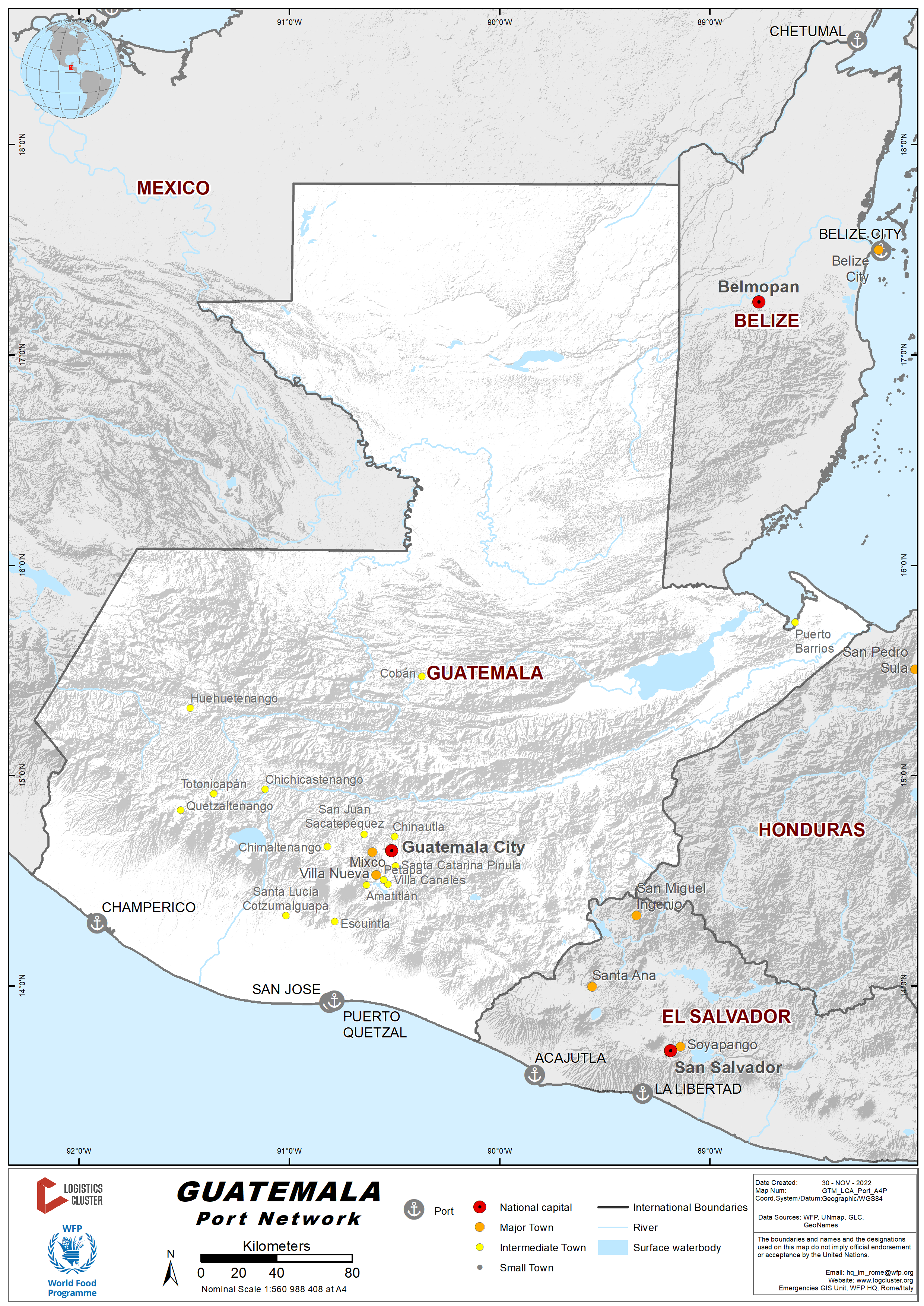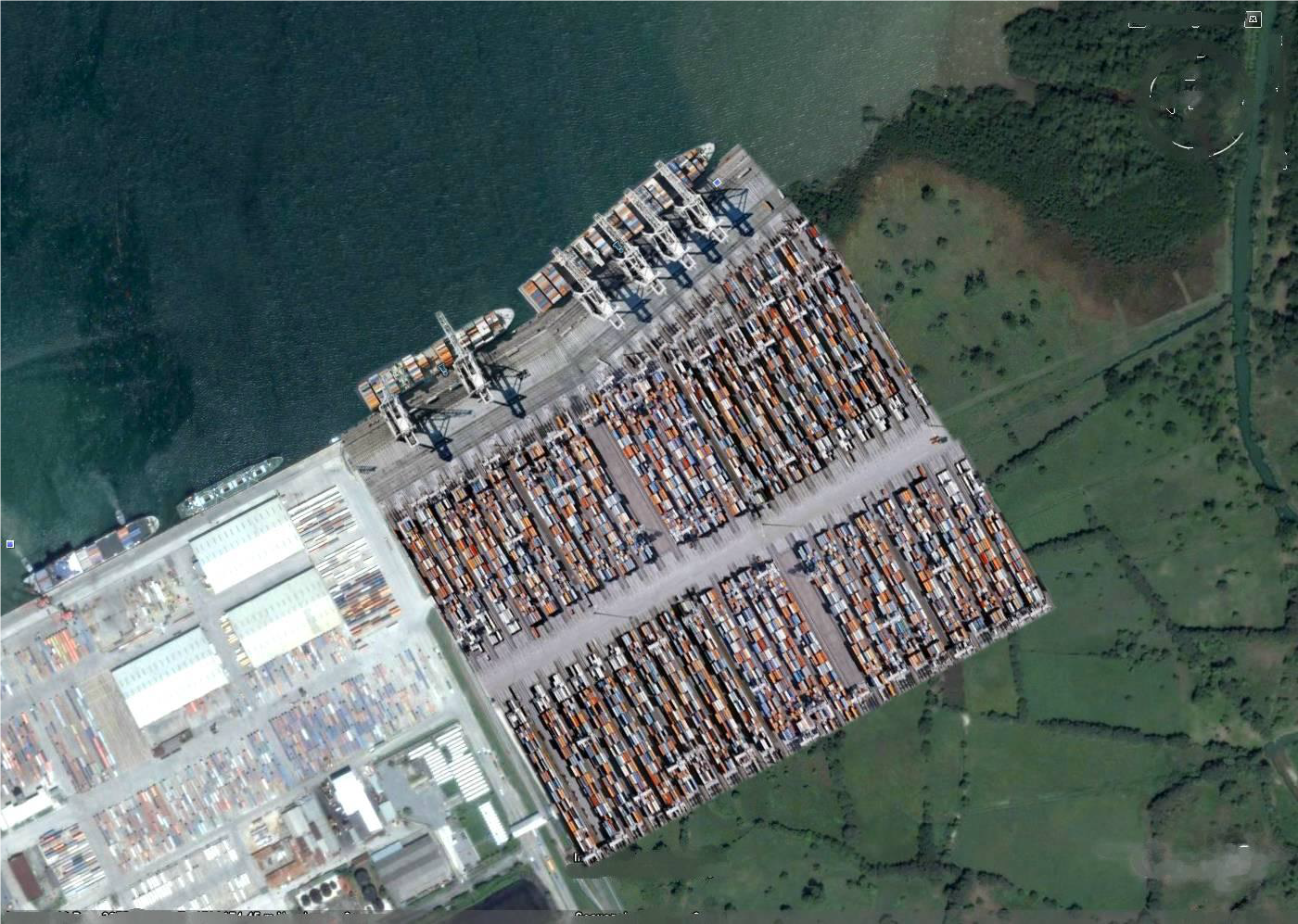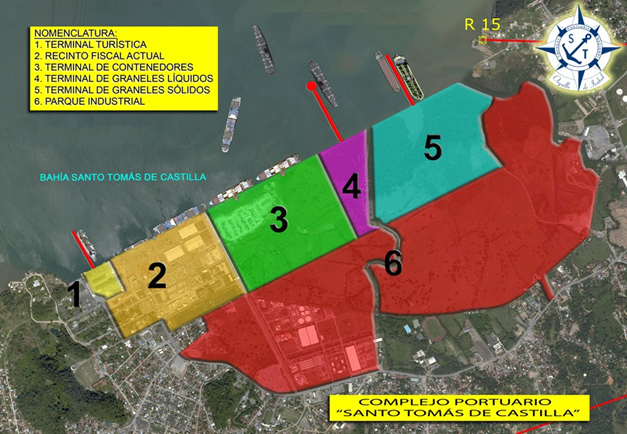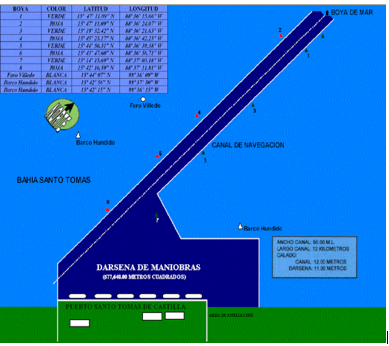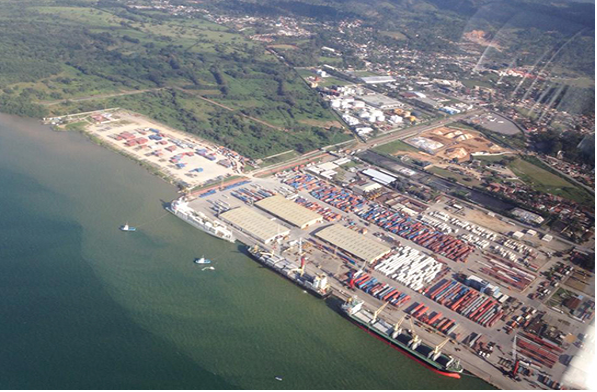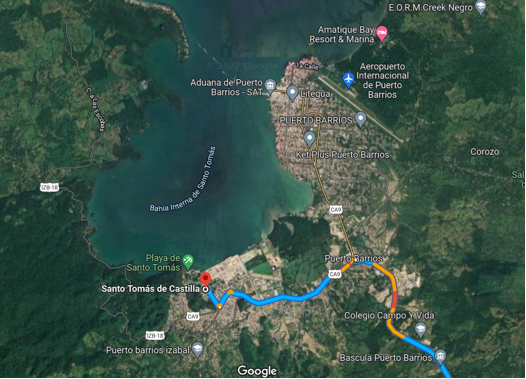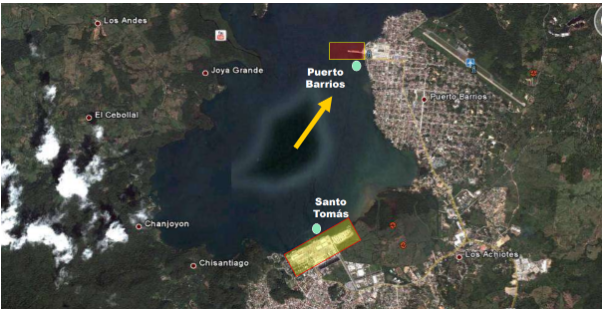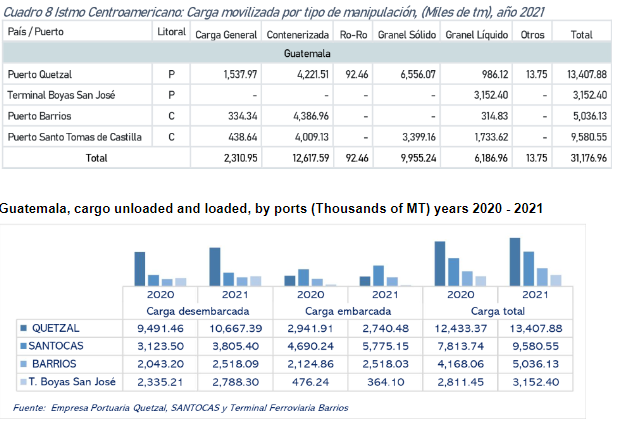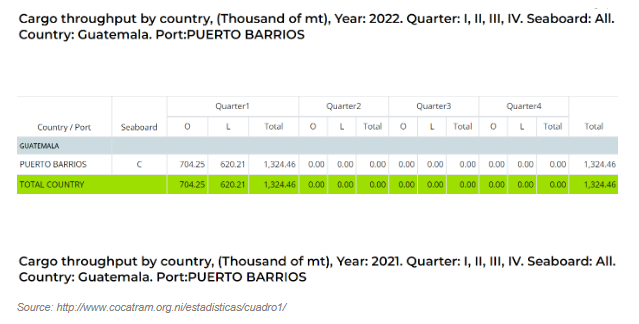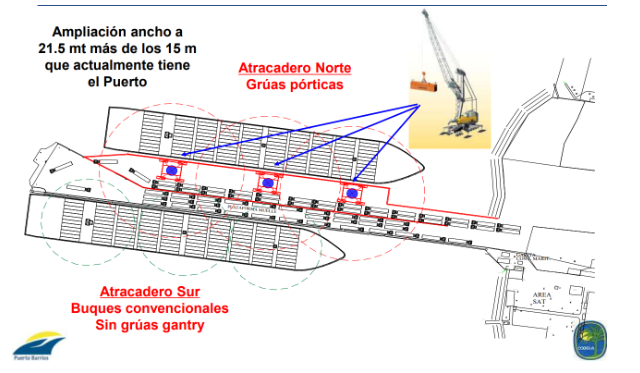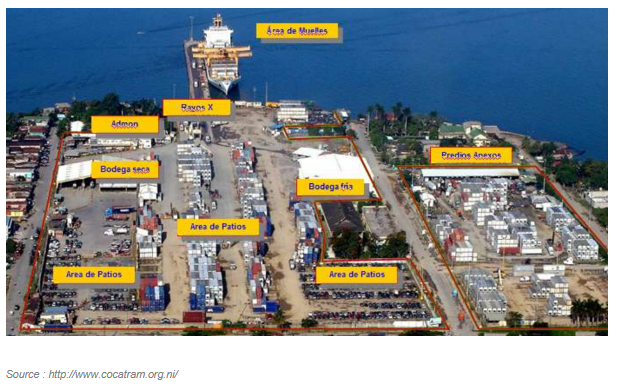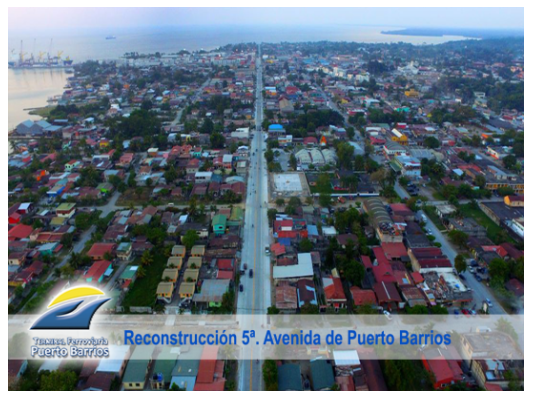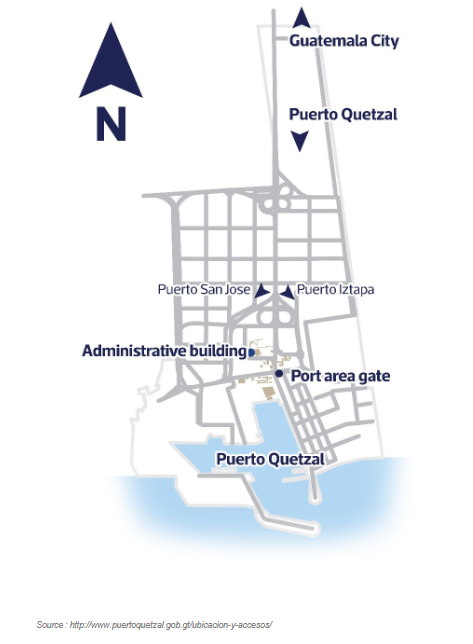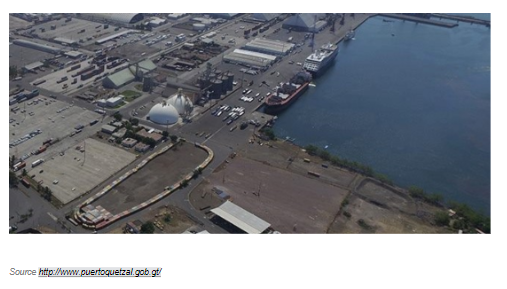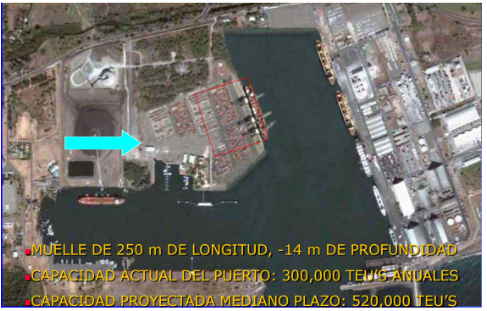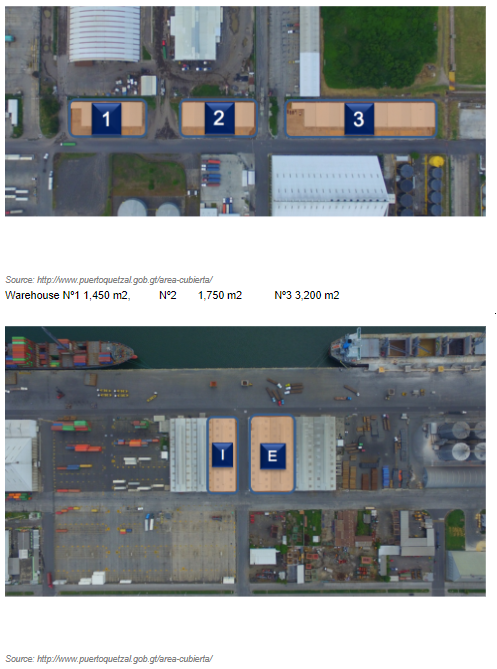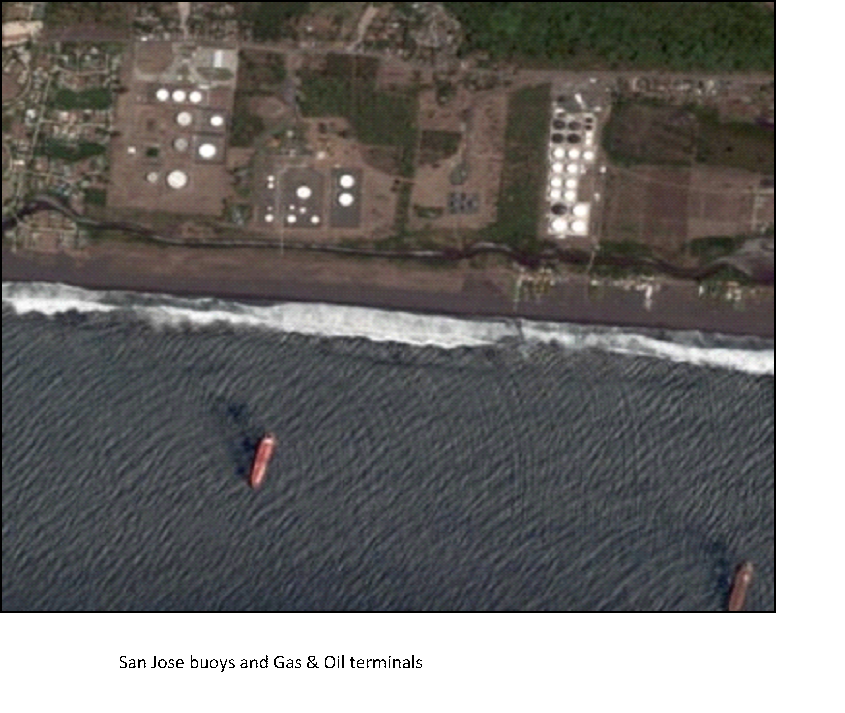2.1 Guatemala Port Assessment
Guatemala's port infrastructure consists of two ports on the Atlantic coast: Santo Tomas de Castilla and Puerto Barrios, and three in the Pacific side: Puerto Quetzal, Puerto de San Jose and Champerico. Port Quetzal and Santo Tomas de Castilla, are government ports with duties and responsibilities defined by the Constitution of the Guatemala. Puerto Barrios is a government onerous usufruct to the Chiquita Brands Company that will continue for 37 more years.
The National Port Commission is the government entity responsible for providing support, coordination, technical expertise to improve the management of the Guatemalan ports and their exposure to the world market. The CPN comprises of representatives of the port companies, relevant government ministries as well as representative of the private sector.
Source : www.cpn.gob.gt
In the Atlantic coast, the ports are located at 295 Km from Guatemala City, and in the Pacific Coast, Puerto Quetzal, and Boyas San Jose are located 100 Km from Guatemala City. Puerto Quetzal has all the infrastructure for exporting sugar, mainly by Expogranel. The port has the more efficient sugar loading terminal in Latin America. Also, the port has a Liquefied Gas Terminal (LPG), a Coal Terminal and a Terminal for Cruises.
Boyas San Jose is mainly used for bulk liquids, petroleum, and molasses. It is a terminal that works with mooring buoys at high sea, for the mooring of vessels working with hose connection of landing and shipping, to and from deposits on land.
2.1.1 Guatemala Port of Santo Tomas de Castilla
Port Overview
The Puerto Santo Tomás de Castilla is located at East Coast Central America, Gulf of Honduras, Amatique Bay in Guatemala at 295 Km from Guatemala City. The official UN/Locode of this port is GTSTC. It is also known as SANTO TOMAS , also called Matías de Gálvez port. Santo Tomás has become the busiest port of Guatemala, handling chiefly general cargo, while Puerto Barrios is limited to agricultural produce. It is the gateway for 60% of Guatemala's containerized cargo, and 65% of liquid bulk. Likewise, it is the export port for Nickel from the Atlantic coast of Guatemala. It is also the headquarters of the Guatemalan navy. Guatemala City is linked to Santo Tomás by highway, and air. Santo Tomás is a medium-sized port. The terminal can handle dry bulk (grains and fertilizers), cruise ships, barges, and reefers, roll on roll off, liquid bulk and containerized cargo.
The Santo Tomás de Castilla National Port Company is the institution responsible for managing and providing maritime port services, such as passenger embarkation and disembarkation, loading, unloading, transfer of merchandise and related services, also to facilitate trade logistics and operations
The Port of Santo Tomás has a fiscal area for liquid bulk, called the Free Zone for Industry and Commerce, also known as ZOLIC, which has 90% of the liquid cargo storage terminals for the aforementioned port.
Zolic: https://en.wikipedia.org/wiki/Zolic http://www.zolicguate.com/
Port website: https://santotomasport.com.gt/
|
Port Location and Contact |
|
|---|---|
|
Country |
Guatemala |
|
Province or District |
Santo Tomas de Castilla Puerto Barrios, Izabal |
|
Nearest Town or City with Distance from Port |
Puerto Barrios 7.7 Km |
|
Port's Complete Name |
Puerto Santo Tomás de Castilla UN/Locode: GTSTC |
|
Latitude |
15° 41' 41" N |
|
Longitude |
88° 36' 59" W |
|
Managing Company or Port Authority |
Empresa Portuaria Nacional Santo Tomas de Castilla Guatemala C.A. www.empornac.gob.gt |
|
Management Contact Person |
Kevin Gabriel Comas / gerenciageneral@empornac.gob.gt Phone: 502 7948-3060 Fax: 502 7948-3288 |
|
Nearest Airport and Airlines with Frequent International Arrivals/Departures |
Airport Name: Aeropuerto de PUERTO BARRIOS Airlines: TAG, Transportes Aereos de Guatemala (Charter) and Private planes |
Port picture
- Cruise Terminal
- Customs bonded warehouse
- Container terminal
- Liquid bulk terminal
- Solid bulk terminal
- Industrial park
Description and Contacts of Key Companies
Proveedora Maya Tzutujil Ship Chandlers
Phone: +502 3103-1379
Fax : +502 4051-4410
sales-jgm@mayatzutujil-supplier.com
Alopsa,
Asistencia y Logistica Portuaria, S.A. Shipping Agency, Ship Chandlers and Container Terminal
Phone: +502 2224-6400
Fax : +502 2224-6422
MECO Ship Chandlers
Phone: +502 3151-4848
Comercializadora Pahame Bulk Logistics, Port and Terminal Services
Phone: +502 2224-6400
Fax : +502 2224-6422
For more information on port contacts, please see the following link: 4.4 Port and Waterways Companies Contact List.
Port Performance
The maximum length of the vessels recorded to having entered this port is 244 meters. The maximum draught is 10.2 meters. The maximum Deadweight is 74,996 t.
|
Seasonal Constraints |
||
|---|---|---|
|
Occurs |
Time Frame |
|
|
Rainy Season |
YES |
May to November |
|
Major Import Campaigns |
NO |
|
|
Other Comments |
Major Export Campaigns from November to April |
|
|
Handling Figures for 2021 |
|
|---|---|
|
Vessel Calls |
1,156 |
|
Container Traffic (TEUs) |
546,676 |
The types of vessels regularly calling at Puerto Santo Tomás are Oil/Chemical Tanker (29%), Container Ship (27%), Bulk Carrier (15%), General Cargo (7%), Crude Oil Tanker (5%).
|
Handling Figures Bulk and Break Bulk for YEAR 2013 |
|
|---|---|
|
Bulk (MT) |
9,531,693 mt |
|
Break bulk (MT) |
N/A |
Discharge Rates and Terminal Handling Charges
For information on port rates and charges, please see the following link: https://santotomasport.com.gt/tarifas/
Berthing Specifications
|
Type of Berth |
Quantity |
Length (m) |
Maximum Draft (m) |
Comments |
|---|---|---|---|---|
|
Conventional Berth |
6 |
913.2 m (total) |
Dock Berths 1, 2, 3: 2.50 m ± 0.25 m Dock Berths 4, 5, 6: 2.70 m ± 0.25 m |
|
| Container Berth |
5 (of 6 total) |
152.20m each |
10m to 10.30 m |
|
|
Silo Berth |
The grain terminal is located in Zone 1, with an area extension of 39,800 m², 75 m away from the wharf’s platform. The terminal counts with six silos with a storage capacity of 3,880 t and a 10,000 t warehouse capacity. It operates using a system of treadmills to load and discharge. |
|||
|
Berthing Tugs |
4 (3,600HP) |
1 Type “A” classification tug |
||
|
Water Barges |
n/a |
Water supply YES |
Water Depth
Cargo Pier: 26 – 30 feet, 7.1 – 9.1 m.
Anchorage: 26 – 30 feet, 7.1 – 9.1 m.
Oil Terminal: 26 – 30 feet, 7.1 – 9.1 m.
Mean Tide: 2 feet
Channel: 26 – 30 feet, 7.1 – 9.1 m.
The maximum length of the vessels recorded to having entered this port is 244 meters. Maximum vessel length overall (LOA) is 229 m. The maximum draught is 10.2 meters.
Control Tower
Located on channel 16 VHF
Access
The access channel to the Port of Santo Tomas de Castilla is located in the entrance of the bay of Amatique (15° 57' 8" North 88° 37' 24’’ West), 2 km towards the West (15° 53 ' 36") it has a turn of 90º degrees. The channel has draught restriction of 11m, length of 10.7 km and a width of 90m
Maritime signalling
Buoys, beacons, leading lights (21 signals plus the Villedo lighthouse) (direction of N 4 degrees 53')
General Cargo Handling Berths
Santo Tomás de Castilla has 6 berths, each one 152.20 meters long, making a total of 913.2 meters of berthing frontage. Of these 6 berths, all are multipurpose, which gives versatility and flexibility to port operations, being berth number 6, the one with the connections for unloading liquid bulk; Likewise, during the cruise season in the Guatemalan Caribbean, the pier assigned to attend to passenger ships is Berth 1.
|
Cargo Type |
Berth Identification |
|---|---|
|
Imports - Bagged Cargo |
Berth 3,4,5,6 |
|
Exports - Bagged Cargo |
Berth 3,4,5,6 |
|
Imports and Exports - RoRo |
Berth 3,4,5 |
|
Other Imports |
Please see below list |
Berth Nº1 Maximum Draft: 10 m. Length: 152.20m. Most common uses: Passengers, containers, RO/RO, conventional vessels, general cargo
Berth Nº2 Maximum Draft: 10 m. Length: 152.20m. Most common uses: Passengers, containers, RO/RO, conventional vessels, general cargo
Berth Nº3 Maximum Draft: 10.30 m. Length: 152.20m. Most common uses: Solid bulk, containers, RO/RO.
Berth Nº4 Maximum Draft: 10.30 m. Length: 152.20m. Most common uses: Solid bulk, containers, RO/RO.
Berth Nº5 Maximum Draft: 10 m. Length: 152.20m. Most common uses: Containers, RO/RO, general cargo, perishable and refrigerated cargo
Berth Nº6 Maximum Draft: 10 m. Length: 152.20m. Most common uses: Liquid bulk
Port Handling Equipment
The port is own and administered by the Government. Most of the equipment is private own but administered by the Port Authority. The port has 5 mobile cranes, clamshells as well as hoppers and all the necessary equipment for loading and unloading products in containers and bulk.
|
Equipment |
Available |
Total Quantity and Capacity Available |
Comments on Current Condition and Actual Usage |
|---|---|---|---|
|
Dockside Crane |
No |
||
|
Container Gantries |
No |
||
|
Mobile Cranes |
Yes |
5 /104 ton on cable, and 30.5 MT under automatic spreader / each |
Five mobile cranes on tires with a capacity of 104 tons, whose characteristics are: in its maximum capacity under cables it is 104 metric tons; and its capacity under automatic spreader is 30.5 metric tons. One crane out of service. No forecast to come back in operation. Repair date not defined. 20 September 2022. |
|
Reachstacker |
Yes |
4 /40 t |
Operational. Four 40 ton Reach Stacker telescopic container carriers |
|
RoRo Tugmaster (with Trailer) |
Yes |
39 /20 t |
Operational. Two Tractor-trailers with a capacity of 20 tons. 36 wagons of 10 tons of capacity. Two wagons that support a capacity of 20 tons. One wagon of 40 tons of capacity. 27 Headers (4×2) with a capacity of 30 tons and one Header (4×4) with a capacity of 30 tons. |
|
Grain Elevator with Bagging Machines |
No |
||
|
Transtainer |
yes |
14 /35 t |
Operational |
|
Forklifts |
Yes |
|
01 forklift with forks of 16 tons and 03 forklifts of 04 and 05 tons, used to handle double pallets, also has 31 forklifts with forks of 04 and 05 tons; 01 forklift with 04-ton forks, which includes a bale handling equipment. Also 05 forklifts with forks of 03 tons; 01 forklift with 2.5-ton forks and 05 mechanical Pallet Jack. |
Container Facilities
Terminal A for full containers: 10,680 m² / 768 TEU’s
Terminal B for full containers and reefers: 16,418 m² / 1,104 TEUs Terminal C for full containers: 16,400 m² / 1,174 TEUs
Container yard (Private Company Cobigua): 14,128 m² / 1,125 TEUs
Container yard (Private Company Almasilos): 4,000 m² / 200 TEUs
Container yard (Private Company Maersk): 16,400 m² / 1,176 TEUs
Container yard (Private Company Servicios Portuarios): 42,230 m² / 4,450 TEUs
|
Facilities |
20 ft |
40 ft |
|---|---|---|
|
Container Facilities Available |
Yes |
127,222.40 m2 |
|
Container Freight Station (CFS) |
N/A |
|
|
Refrigerated Container Stations |
903 reefer plugs |
|
|
Daily Take Off Capacity |
660/day |
|
|
Number of Reefer Stations |
803 reefer plugs |
Container yard with electricity supply for refrigerated containers with a capacity of 1,408 TEUs (11,558 m2 of area). Currently there are 633 outlets in Patio No.4 and 10B, 4 Power Boxes with a capacity of 60 outlets, plus 1 of 30 for a total of 903 units. |
|
Emergency Take-off Capacity |
1,320/day |
|
|
Off take Capacity of Gang Shift |
N/A |
N/A |
Customs Guidance
When all necessary documentation is presented to the customs authorities and OIRSA, https://www.oirsa.org/ the cargo release process will take an estimate of 5 or 6 days from the time the vessel arrives until cargo is release. The Government of Guatemala has launched since May 2021 a new project with the Global Alliance for Trade Facilitation that will simplify, standardise, and digitise documentation and procedures at its major ports, with benefits that can ripple across its economy. Shipping companies, terminal operators, and captains will spend less time meeting administrative demands when ships arrive, dock at, or leave Guatemalan ports. For the public sector, the switch to automated processes will ease the controls performed by customs, health, agriculture, and immigration authorities and permit more effective coordination. The time saved by improving authorisation and inspection processes can allow ports to receive more ships and save operators as much as USD 3,000 in operational costs per hour for each vessel. Delays in port arrivals and departures stemming from incorrect paperwork and discoordination among several actors can cost ships their place at port berths and lead to late fees and time lost in loading or unloading cargo.
Santo Tomas de Castilla Customs
Inside the Puerto Santo Tomas de Castilla Maritime Port on the main street to the pier at kilometer 298 of the Central American highway CA-9 north, municipality of Puerto Barrios, Department of Izabal. Phone (502) 7960-0350 to 54
Services provided: Dispatch of merchandise (import, export and transit, authorization of tourist permits and their movements).
In the administrative area from Monday to Sunday from 08:00 to 22:00.
For more information on customs in GUATEMALA please see the following link: 1.3 Customs Information.
Terminal Information
MULTIPURPOSE TERMINAL
The general cargo handling berth is on the 810 m long. The “Commercial wharf” which is composed of four berths of 202.5 m is divided as follows: 1 berth for the handling of general cargo, 2 for general solid/liquid cargo, and1 multipurpose ramp (Ro-Ro). The depth is 11m BHZ.
GRAIN AND BULK HANDLING
The grain terminal is located in Zone 1, with an area extension of 39,800 m², 75 m away from the wharf’s platform. The terminal counts with six silos with a storage capacity of 3,880 t and a 10,000 t warehouse capacity. It operates using a system of treadmills to load and discharge. The treadmills’ output is of 1,000 t per hour. The mechanism is designed to handle different products simultaneously
MAIN STORAGE TERMINAL
The port has various storage facilities for containers, both reefers and dry cargo, full and empty, as well as storage space for vehicle. The storage area also includes space for stripping, re-stuffing and transhipment cargo of containers which have short storage time. There is a ramp and cover space for stripping of container and customs inspection. There is also an area for the loaded trucks to wait for customs inspection.
|
Storage Type |
Number of Storage Facilities |
Area (m2) |
|---|---|---|
|
Bagged Cargo |
1 |
28,738 m² |
|
Refrigerated Cargo |
Del Monte has a cold room inside the port facilities for their perishable cargo. |
|
|
General Cargo |
1 |
8,895.54 m² |
Stevedoring
The port has three stevedoring companies for the vessel operations. They are unionized in the organization SINTRAPSATCA
Hinterland Information
Port Security
Port Santo Tomas de Castilla fulfils all the ISPS regulations. Vessels visiting Santo Tomas de Castilla have to fulfil the regulations and requirements of the ISPS code. It is prohibited within the port premises: washing, painting, welding, refuelling.
|
Security |
|
|---|---|
|
ISPS Compliant |
Yes |
|
Current ISPS Level |
1, MARSEC 1 |
|
Police Boats |
Yes |
|
Fire Engines |
Yes |
2.1.2 Guatemala Port of Barrios
Port Overview
Puerto Barrios is located at East Coast Central America, Gulf of Honduras in Guatemala at coordinates N 15° 43' 56.09" - W 088° 36' 26.08". The official UN/Locode of this port is GTPBR. It is also known as PTO BARRIOS,BARRIOS,PBARRIOS Access to the port is done via the Santo Tomas de Castilla Port access channel. The Amatique Bay is used as the anchor area. The breakwater concrete pier handles containerized cargo, general cargo, liquid bulk and dry bulk cargo. The types of ships which can moor are: cruise ships, container ships, tankers, barges, general cargo ship, roll on-roll off cargo and vessels other than the above.
The direction of the pier is to the west. There are four berths: Berth #1 (South) 155m, #2 (South) 140m, #3 (North) 175m and #4 (North) 65m. The draft berths of both South and North of the pier is 9.50m.
With the exception of Berth #4 is used for roll-on roll-off and tugs docking port, the other berths are used for container ships, bulk liquids and solids and general cargo.
The port has storage areas for containers (refrigerated, dry) as well as storage areas for vehicles. The port has a capacity for 2,440 TEU’s. There is no storage area for bulk cargo; therefore grains need to be directly transferred to the trucks.
There are 3 shifts which operate from 07:00 to 16:00, from 16:00 to 23:00 and from 23:00 to 07:00 giving 24 hour attention to vessels. Administrative staff works from Monday to Friday, 07:00 to 12:00 and 14:00 to 17:00
Port website: https://puertobarrios.net/
Key port information may also be found at: http://www.maritime-database.com
|
Port Location and Contact |
|
|---|---|
|
Country |
Guatemala |
|
Province or District |
Izabal |
|
Nearest Town or City with Distance from Port |
Puerto Barrios km: 2 KM |
|
Port's Complete Name |
Terminal Ferroviaria Puerto Barrios |
|
Latitude |
15.72778 (N 15° 43' 42") |
|
Longitude |
-88.59444 (W 088° 36' 26.08") |
|
Managing Company or Port Authority |
Chiquita Guatemala, S.A. and/or COBIGUA - Portuaria Puerto Barrios, operator of Terminal Ferroviaria Puerto Barrios Diagonal 5, 10-65 zona 10, Centro Gerencial Las Margaritas, Torre 1, nivel 19, oficina 1902, Guatemala City Terminal Ferroviaria Puerto Barrios 9ª Calle, entre 1ª y 2ª Avenida, Puerto Barrios, Izabal. |
|
Management Contact Person |
Superintendente Abel Cruz Calderón. Other contact: Andrés Vargas jefe de logística @Chiquita Latam Edwin de Paz edepaz@chiquita.com |
|
Nearest Airport and Airlines with Frequent International Arrivals/Departures |
Airport Name: Puerto Barrios Airport (PBR) (Aeropuerto Internacional de Puerto Barrios) Airlines: TAG, Transportes Aereos de Guatemala (Charter) and Private planes. COBIGUA has a weekly flight for company personnel. Contact port superintendent to request permission to fly in this aircraft. |
Port Picture
Description and Contacts of Key Companies
The loading/unloading goods of handled is by the port’s operations personnel who supervise the labourers. Private companies carry out stevedoring operations on board of the ships.
Three private companies provide transport services from the quay side to the storage areas. Those companies, and the port management, own and operate front loaders and forklifts to move the cargo and containers in the yard.
An indoor area is used for the stripping of containers for Customs (SAT) revision. The port also counts with a parking lot for loaded trucks waiting for the SAT inspection. There are also three container storage areas for export outside the port area, two of them specifically used by DOLE Company and one by COBIGUA.
For more information on port contacts, please see the following link: 4.4 Port and Waterways Companies Contact List.
Port Performance
Puerto Barrios is a small port, but woks very efficiently. Average waiting time is less than 5 hours if vessels are included in the weekly program. For humanitarian cargo, contact the port superintendent.
The maximum length of the vessels recorded to having entered this port is 226 meters. The maximum draught is 11.1 meters. The maximum Deadweight is 63495t.
|
Seasonal Constraints |
||
|---|---|---|
|
Occurs |
Time Frame |
|
|
Rainy Season |
Yes |
May to October |
|
Major Import Campaigns |
Yes |
Nov to April |
| Other Comments | Load line zone: North Pacific Seasonal Tropical Area, Tropical Mar 1 to Jun 30 and Nov 1 to Nov 30, Summer Jul 1 to Oct 31 and Dec 1 to Feb 28/29. | |
The types of vessels regularly calling at PUERTO BARRIOS are Container Ship (47%), General Cargo (18%), Oil/Chemical Tanker (18%), Reefer (2%), Reefer/Containership (2%).
Guatemala, cargo volume movement by type of cargo (Thousands of MT) year 2021
|
Handling Figures for 2021 |
|
|---|---|
|
Vessel Calls |
602 |
|
Container Traffic (TEUs) |
547,667 (479,667 in 2020) |
|
Handling Figures Bulk and Break Bulk for 2022 |
|
|---|---|
|
Bulk (MT) |
1,324.46 (5,036.13 in 2021) |
|
Break bulk (MT) |
N/A |
Source: Empresas Portuarias de Centroamérica y Autoridad Marítima de Panamá
Discharge Rates and Terminal Handling Charges
THC rates are highly variable. Please check rates on case by case basis.
THC/L - Terminal Handling Charge in Port of Loading, Puerto Santo Tomas De Castilla (GTZST), Puerto Barrios (GTPBR): 20',40'&40'HC: USD 145 40' reefer USD 195 (Effective : 25/03/2022)
Berthing Specifications
|
Type of Berth |
Quantity |
Length (m) |
Maximum Draft (m) |
Comments |
|---|---|---|---|---|
|
Conventional Berth |
1 pier, 4 berths |
See comments |
9.5m |
There are four berths: Berth #1 (South) 155m, #2 (South) 140m, #3 (North) 175m and #4 (North) 65m. |
|
Container Berth |
N/A |
|
|
|
|
Silo Berth |
N/A |
|
|
|
|
Berthing Tugs |
|
|
|
1 (2 engines of 2,974 HP)
1 (957 mt)
1 (859 mt) |
|
Water Barges |
1 |
|
|
|
Port Barrios shares part of the Puerto Santo Tomas access channel. It is located in the entrance of the bay of Amatique (15° 57' 8" North 88° 37' 24’’ West), 2 km towards the West (15° 53 ' 36") it has a turn of 90º degrees. The channel has draught restriction of 11m, length of 10.7 km and a width of 90m
The direction of the pier is to the west. There are four berths: Berth #1 (South) 155m, #2 (South) 140m, #3 (North) 175m and #4 (North) 65m. The draft berths of both South and North of the pier is 9.50m.
With the exception of Berth #4 is used for roll-on roll-off and tugs docking port, the other berths are used for container ships, bulk liquids and solids and general cargo
Channel: 31-35 feet, 9.4-10 m Cargo Pier: 16-20 feet, 4.9-6.1m. Oil Terminal: 16-20 feet, 7-9m
Max size: LOA 183M. Max draft: 9.5m. Mean Tide: 1 foot Anchorage: 26-30 feet, 7.1-9.1m
The port has facilities for handling bananas, grain, fertilisers and oil.
The port has storage areas for containers (refrigerated, dry) as well as storage areas for vehicles. The port has a capacity for 2,440 TEU’s.
There is no storage area for bulk cargo; therefore grains need to be directly transferred to the trucks.
General Cargo Handling Berths
|
Cargo Type |
Berth Identification |
|
|---|---|---|
|
Imports - Bagged Cargo |
Berth #1, #2, #3 |
|
|
Exports - Bagged Cargo |
Berth #1, #2, #3 |
|
|
Imports and Exports - RoRo |
With the exception of Berth #4 is used for roll-on roll-off and tugs docking port, the other berths are used for container ships, bulk liquids and solids and general cargo |
|
|
Other Imports |
There is no storage area for bulk cargo; therefore grains need to be directly transferred to the trucks. |
|
Port Handling Equipment
|
Equipment |
Available
|
Total Quantity and Capacity Available |
Comments on Current Condition and Actual Usage |
|---|---|---|---|
|
Dockside Crane |
No |
|
|
|
Container Gantries |
No |
|
|
|
Mobile Cranes |
Yes |
03 Liebherr / 124 ton ea. |
LHM 420, for ships in the Post-Panamax class. Mobile harbour crane raises and lowers loads at up to 120 metres per minute. The LHM 420 has a maximum load capacity of 124 tonnes and handles up to 38 containers per hour. It is also suitable for the efficient handling of bulk cargoes, and general cargoes. All three 03 cranes are operational |
|
Reachstacker |
Yes |
12 |
|
|
RoRo Tugmaster (with Trailer) |
Yes |
82 |
|
|
Grain Elevator with Bagging Machines |
No |
|
There is no storage area for bulk cargo; therefore grains need to be directly transferred to the trucks. |
|
Transtainer |
No |
|
|
|
Forklifts |
Yes |
19 |
9 x 4t, 8 x 3t, 2 x 10t |
Container Facilities
|
Facilities |
20 ft |
40 ft |
|---|---|---|
|
Container Facilities Available |
2,440 TEU’s 450,000 TEU’s annual capacity |
- |
|
Container Freight Station (CFS) |
N/A |
|
|
Refrigerated Container Stations |
250 / 600 |
|
|
Other Capacity Details |
680 trucks in/out daily 24 inspection ramps |
|
|
Daily Take Off
Capacity
|
114 containers / day |
|
|
Number of Reefer
Stations
|
1100 plug stations |
|
|
Emergency Take-off Capacity |
114 containers Max. |
|
|
Off take Capacity of Gang
Shift
|
N/A |
|
Customs Guidance
Puerto Barrios is a Temporary Customs Warehouse (DAT) for @SATGT. When all necessary documentation is presented to the customs authorities and OIRSA, https://www.oirsa.org/ the cargo release process will take an estimate of 5 or 6 days from the time the vessel arrives until cargo is release. The Government of Guatemala has launched since May 2021 a new project with the Global Alliance for Trade Facilitation that will simplify, standardise, and digitise documentation and procedures at its major ports, with benefits that can ripple across its economy. Shipping companies, terminal operators, and captains will spend less time meeting administrative demands when ships arrive, dock at, or leave Guatemalan ports. For the public sector, the switch to automated processes will ease the controls performed by customs, health, agriculture, and immigration authorities and permit more effective coordination. The time saved by improving authorisation and inspection processes can allow ports to receive more ships and save operators as much as USD 3,000 in operational costs per hour for each vessel. Delays in port arrivals and departures stemming from incorrect paperwork and discoordination among several actors can cost ships their place at port berths and lead to late fees and time lost in loading or unloading cargo.
Puerto Barrios Customs
Within the Puerto Barrios seaport on 9th Final Street, Colonia Las Champas, Municipality of Puerto Barrios, Department of Izabal. Tel. (502)7948-0595, (502)7948-0132, (502)7948-2375, (502)7948-1554 and (502)7948-7943.
Services provided: Dispatch of goods (import, export and transit).
Open from, to: In the administrative area: from Monday to Friday, from 08:00 to 16:00.
In the operational area: Monday to Sunday, from 07:00 to 23:00. Extraordinary services are authorized from 11:00 p.m. to 7:00 a.m. Delegation Entre Ríos: From Monday to Sunday, from 06:00 to 18:00.
For more information on customs in GUATEMALA, please see the following link: 1.3 Customs Information.
Terminal Information
MULTIPURPOSE TERMINAL
No information available
GRAIN AND BULK HANDLING
There is no storage area for bulk cargo; therefore grains need to be directly transferred to the trucks. The port has handling facilities for discharge grain and bulk directly from ship, but no bagging equipment.
MAIN STORAGE TERMINAL
The Port of Barrios has no functional storage space for dry cargo.
|
Storage Type |
Number of Storage Facilities |
Area (m2) |
|---|---|---|
|
Bagged Cargo |
N/A |
|
|
Refrigerated Cargo |
6 |
2,250 pallets |
|
General Cargo |
N/A |
Stevedoring
The stevedoring services are subcontracted by Puerto Barrios. Fees are already included in the port tariffs. The loading/unloading goods of handled is by the port’s operations personnel who supervise the labourers. Private companies carry out stevedoring operations on board of the ships. Stevedoring services can be coordinated directly with companies such as Serpa or Omarsa, and they will organize the vessel unloading.
Hinterland Information
Heavy and light vehicle access to the terminal in/out is normally done through the main avenue Avenida de Puerto Barrios. Inside the terminal premises three private companies provide transport services from the quay side to the storage areas. Those companies, and the port management, own and operate front loaders and forklifts to move the cargo and containers in the yard. An indoor area is used for the stripping of containers for Customs (SAT) revision. The port also counts with a parking lot for loaded trucks waiting for the SAT inspection. There are also three container storage areas for export outside the port area, two of them specifically used by DOLE Company and one by COBIGUA.
Port Security
Non-intrusive X-ray inspection system for containers. Since 1990, Puerto Barrios has continually increase security in the port premises. In 2004 the port implemented the international code of Vessel Protection. Also the port has CCTV in all port premises, access control, Vessel Monitoring (AIS), Canine unit.
|
Security |
|
|---|---|
|
ISPS Compliant |
YES |
|
Current ISPS Level |
1 |
|
Police Boats |
YES |
|
Fire Engines |
YES |
2.1.3 Guatemala Port Of Quetzal
Port Overview
Puerto Quetzal, UN/LOCODE GTPRQ, also known as PTO QUETZAL,QUETZAL is located on the southwestern Pacific Ocean coast of Guatemala about 55 kilometres northwest of the border with El Salvador. It is Guatemala’s biggest Pacific Ocean port, important for both cargo and as a stop-over for cruise passengers, located about five kilometres east of Guatemala’s Port of San Jose; 98 kilometres from Guatemala City, about 80 minutes on the highway to Puerto Quetzal.
It is the gateway for solid bulk and containers from Guatemala, and for fuels for the western part of the country. Likewise, it is the door through which sugar and its derivatives such as molasses and alcohols are exported. It has an annual container throughput capacity of 450,000 TEU’s (2022) and is currently the largest facility between the port of Lázaro Cardenas in México, and the Panama Canal, on the west coast of Central America. It is the only terminal in Guatemala capable of handling 10,000 TEU vessels due to its 14.5 m max. draft.
Puerto Quetzal has a privileged geographical position in the Central America Region as it is situated in an equidistant point to the Panama Canal and the big Mexican ports in the Pacific.
The Empresa Portuaria Quetzal is the institution responsible for the management and administration of Puerto Quetzal; they foresee that in 2023 Puerto Quetzal will be an intelligent port, the first of its kind in all of Central America, the third or fourth in Latin America excluding Panama.
APM Container Terminal, https://www.apmterminals.com/en/puerto-quetzal , is the main terminal operator, according to its master plan [1mn TEU’s / year] it should have carried out its second phase of invetsments, which is another berth, equipment and yards, in 2019. Due to a current legal situation with the Guatemalan government, it has not been done, so the capacity of the port has already reached its limit above 60%, and that the international demand is very high, so it is required that the expansion phase continue that it had in its port conception plan when it began operations. If more investments are not made, there will be more and more congestion with delays in container export cargo.
At the closure of the present LCA edition 2022, the Guatemalan government is currently negotiating with APM the purchase of the container terminal.
APM Institutional video Puerto Quetzal: https://youtu.be/yow5OBs2NQM
Port website: www.puertoquetzal.gob
Key port information may also be found at: http://www.maritime-database.com
|
Port Location and Contact |
|
|---|---|
|
Country |
Guatemala |
|
Province or District |
Escuintla |
|
Nearest Town or City with Distance from Port |
Name: San Jose km: 5 km (next town: Escuintla 41 km) |
|
Port's Complete Name |
Puerto Quetzal |
|
Latitude |
13º 55' 00.0382 N (N13°55′50.27) |
|
Longitude |
90º 47' 03.7361 W (E -90°45′28.92) |
|
Managing Company or Port Authority |
Empresa Portuaria Quetzal Km. 102 Autopista Escuintla Puerto Quetzal, Guatemala, C.A. PBX: (502) 7828-3500 Offices in Guatemala City 4a. Calle 7-53 Zona 9, Edificio Torre Azul, 1er. Nivel Oficina 105 Guatemala, C.A. 01009 Tel. (502) 2312-5000 |
|
Management Contact Person |
General Manager Francisco Antonio Anleu Quijada Operations Manager Mario Véliz Lopez Ludwin Apixola estadisticas@quetzal.com Focal point for Estadísticas Portuarias - COCATRAM Phone (502) 7828-3500 |
|
Nearest Airport and Airlines with Frequent International Arrivals/Departures |
Guatemala La Aurora Int'l, 110 km Airlines: Private planes |
Port Picture
Puerto Quetzal facilities can accommodate Panamax-size vessels and can serve carriers of solid and liquid bulk cargoes, containers, roll-on/roll-off cargoes, cruise fleets, fishing boats, sailboats, frigates, and recreational vessels. The port authority or the Empresa Portuaria Quetzal operates and administers the port functions. The harbour of this port is sheltered by breakwaters. The main dock is near the eastern side of the harbour and is 1,140 meters long.
The port contains 437 thousand square meters of storage space, 5.6 thousand square meters of warehouse, 8 thousand square meters of sheds, and an open storage area of 21.3 thousand square meters. An additional 2.1 thousand square meters is available for handling roll-on/roll-off cargoes, and 16.4 thousand square meters is available for vehicles. Its facilities are home to the largest storage facilities for grain, fuel, molasses, sugar and other solid and liquid cargo that moves in the port.
List of the areas identified in the Port Picture: http://www.puertoquetzal.gob.gt/muelle/
Description and Contacts of Key Companies
Index
For more information on port contacts, please see the following link: 4.4 Port and Waterways Companies Contact List.
Port Performance
It is the only terminal in Guatemala capable of handling 10,000 TEU vessels due to its 14.5 m max. draft.
The port can handle huge vessels and is operational all year. The commercial dock has four berths. Its main berth is 820 meters long and can accommodate ships with 11 meters draft. It handles general cargo. The other two berths handle both solid and liquid cargo and it also has a multipurpose ramp, plus a 203 m long container berth and three berthing tugs.
List of main shipping lines serving the port: ALIANCA, APL, CCNI, COSCO, CHINA SHIPPING, CMA CGM, CP SHIPS, HAMBURG SUD, Hapag Lloyd, HANJIN, LIBRA, Maersk, NORASIA, NYK, Seaboard, Wan Hai
Traffic figures: Approx 5,000,000 mt of cargo, 1,100 vessels, 17,000 passengers and 550,000 TEU are handled annually. Reduced waiting time for vessels due to dedicated berthing windows
The main commercial dock is situated in the eastern part of the harbour. The W basin houses a cruise jetty, with a power station on its N side and an LPG terminal on the S side.
The harbour is protected by breakwaters; the major dock is 1,140m in length; the minor of 307m in length; with also a dyke of 367m. The main dock is situated in the eastern part of the harbour.
Control tower: Located on channel 16 VHF.
Max vessel size: LOA 280m, beam 32m, draught 10.5m.
Max. Size: Draft 11.1 m. (tidal). Containers: Draft 11.1 m. (tidal). Passengers: Draft 12.0 m. (tidal). Ro-Ro: Draft 11.1 m. (tidal). Bulk: Draft 11.1 m. (tidal). Tankers: Draft 11.6 m. (tidal). Gas: Draft 12.5 m. (tidal).
|
Seasonal Constraints |
||
|---|---|---|
|
Occurs |
Time Frame |
|
|
Rainy Season |
Yes |
May to October |
|
Major Import Campaigns |
Yes |
Sugar cane exports from November to April |
| Other Comments | Load line zone: North Pacific Seasonal Tropical Area, Tropical Mar 1 to Jun 30 and Nov 1 to Nov 30, Summer Jul 1 to Oct 31 and Dec 1 to Feb 28/29. | |
The types of vessels regularly calling at PUERTO QUETZAL are Bulk Carrier (31%), Container Ship (29%), Oil/Chemical Tanker (20%), General Cargo (6%), Vehicle Carrier (5%).
Guatemala cargo movement chart, by type (Thousands of MT) during year 2021
|
Handling Figures for 2021 |
|
|---|---|
|
Vessel Calls |
1,186 |
|
Container Traffic (TEUs) |
581,030 (2020 519,570) |
Guatemala vessel movement chart, year 2021
|
Handling Figures Bulk and Break Bulk for 2021 |
|
|---|---|
|
Bulk (MT) |
13,407.88 mt (2020 12,433.37 mt, +7.8%) |
|
Break bulk (MT) |
1,537.97 thousand mt |
Discharge Rates and Terminal Handling Charges
THC rates are highly variable. Please check rates on case by case basis.
For information on port rates and charges, please see the following link:
http://www.puerto-quetzal.com/web/guest/tarifa
Berthing Specifications
|
Type of Berth |
Quantity |
Length (m) |
Maximum Draft (m) |
Comments |
|---|---|---|---|---|
|
Conventional Berth |
02 |
820m |
11m |
Commercial Dock: 2 berths to handle general cargo; 2 for solid/liquid general cargo; 1 multipurpose ramp. Dimensions: 820 meters long Depth: 11 meters. It offers space for four (04) vessels. |
|
Container Berth |
|
|
|
|
|
Silo Berth |
|
|
11m |
The grain terminal is situated in Zone 1 and spans 39,800 m². The terminal has six silos with a storage capacity of 3,880 tonnes |
|
Berthing Tugs |
3 (1 port, 2 private*) |
|
|
*Azimut type: Robert Allan R Amparts 2300MM, has a length of 23 meters, CAT 3512C engines and Rolls Royce US205 FP azimuth thrusters, with a speed of approximately 12 knots. (Bollard Pull) of 60 tons. |
|
Water Barges |
N/A |
|
|
Water supply, Yes |
The main berth is 820m long with 11 meters draft. It offers space for four (04) vessels.
The “Commercial wharf” which is composed of four berths of 202.5 m is divided as follows: 1 berth for the handling of general cargo, 2 for general solid/liquid cargo, and1 multipurpose ramp (Ro-Ro). The depth is 11m BHZ.
Coal and Fuel Terminal: 1 berth formed by 4 dolphin pilings, for unloading mineral coal and fuels.
Dimensions: 10.67 meters long and 10.36 meters wide
Depth: 12 meters.
Cruise Terminal: 1 berth formed by 6 dolphin piling, for the berthing of passenger ships.
Dimensions: 185 meters long
Depth: 13 meters.
Services or Link Dock: connection between the general dock and the south dock, it is used to maintain small boats.
Dimensions: 50 meters long and 40 meters wide
Depth: between 5 and 11 meters.
Auxiliary Dock: 1 berth to handle general cargo (shallow draft vessels) on the north side.
Dimensions: 170 meters long
Depth: 5 meters
Gas Terminal: 1 berth formed by 2 retention piles and 6 mooring piles, with specialized connections for the discharge of liquefied petroleum gas (LPG).
Dimensions: 58 meters long
Depth: 13 meters.
General Cargo Handling Berths
The general cargo handling berth is on the 810 m long. The “Commercial wharf” which is composed of four berths of 202.5 m is divided as follows: 1 berth for the handling of general cargo, 2 for general solid/liquid cargo, and1 multipurpose ramp (Ro-Ro). The depth is 11m BHZ.
|
Cargo Type |
Berth Identification |
|---|---|
|
Imports - Bagged Cargo |
N/A |
|
Exports - Bagged Cargo |
N/A |
|
Imports and Exports - RoRo |
1 multipurpose ramp (Ro-Ro) at the Commercial Wharf |
|
Other Imports |
N/A |
Port Handling Equipment
Is the port equipment managed by the government or privately? Privately
Currently operating at around 60% capacity, the terminal is equipped with three Super Post Panamax Ship-to-Shore cranes (20 container outreach) on a 350m quay. With 610 reefer plugs, the terminal handles fruits and vegetables, coffee, grains, fertilizer, fish, cotton, textiles and tobacco.
|
Equipment |
Available
|
Total Quantity and Capacity Available |
Comments on Current Condition and Actual Usage |
|---|---|---|---|
|
Dockside Crane |
Yes |
03 three Super Post Panamax Ship-to-Shore cranes |
Operational, Kone |
|
Container Gantries |
Yes |
05 / 60 tons |
Operational |
|
Mobile Cranes |
No |
1 of 36 t, 4 of 45 t, 1 of 42 t |
|
|
Reachstacker |
Yes |
14 / 40 ton ea. |
|
|
RoRo Tugmaster (with Trailer) |
Yes |
20 Tug and trailer |
|
|
Grain Elevator with Bagging Machines |
Yes |
|
|
|
Transtainer |
Yes |
05 / 60 tons |
Operational |
|
Forklifts |
Yes |
50 |
|
Container Facilities
Terminal A for full containers: 10,680 m² / 768 TEU’s
Terminal B for full containers and reefers: 16,418 m² / 1,104 TEU’s Terminal C for full containers: 16,400 m² / 1,174 TEU’s
Container yard APM: 130,000 m2
Container yard (Private company Cobigua): 14,128 m² / 1,125 TEU’s
Container yard (Private company Almasilos): 4,000 m² / 200 TEU’s
Container yard (Private company Maersk Sealand): 16,400 m² / 1,176 TEU’s
Container yard (Private company Servicios Portuarios): 42,230 m² / 4,450 TEU’s
|
Facilities |
20 ft |
40 ft |
|---|---|---|
|
Container Facilities Available |
Yes |
Yes |
|
Container Freight Station (CFS) |
Yes |
Yes |
|
Refrigerated Container Stations |
_ |
610 Reefer positions |
|
Other Capacity Details |
|
Annual container throughput capacity of 340,000 TEU. Rapid truck turnaround times are made possible thanks to 5 gate lanes and a digital appointment system |
|
Daily Take Off Capacity |
_ |
930 TEUs /day |
|
Number of Reefer Stations |
_ |
610 reefer plugs |
|
Emergency Take-off Capacity |
_ |
1000 TEUs /day |
|
Off take Capacity of Gang Shift |
N/A |
|
Customs Guidance
There are no unique customs formalities for Port of Quetzal. Inside Port Quetzal the SAT office is the busiest customs office from Guatemala, followed by Santo Tomas and Guatemalan central customs office.When all necessary documentation is presented to the customs authorities and OIRSA, https://www.oirsa.org/ the cargo release process will take an estimate of 5 or 6 days from the time the vessel arrives until cargo is release. The Government of Guatemala has launched since May 2021 a new project with the Global Alliance for Trade Facilitation that will simplify, standardise, and digitise documentation and procedures at its major ports, with benefits that can ripple across its economy. Shipping companies, terminal operators, and captains will spend less time meeting administrative demands when ships arrive, dock at, or leave Guatemalan ports. For the public sector, the switch to automated processes will ease the controls performed by customs, health, agriculture, and immigration authorities and permit more effective coordination. The time saved by improving authorisation and inspection processes can allow ports to receive more ships and save operators as much as USD 3,000 in operational costs per hour for each vessel. Delays in port arrivals and departures stemming from incorrect paperwork and discoordination among several actors can cost ships their place at port berths and lead to late fees and time lost in loading or unloading cargo.
Puerto Quetzal Customs
Kilometer 111 of the Central American Highway number CA-9 South, Puerto Quetzal. Municipality of San José, Department of Escuintla. Tel. (502) 23297070 Ext. 6130, 6131, 6140 and 6143.
Services provided: Dispatch of goods (import, export and transit).
Open from, to: In administrative areas: Monday to Sunday from 08:00 to 22:00. The Collection and Management area: Monday to Friday from 08:00 to 16:00 and Saturday from 08:00 to 12:00. In operational areas: from Monday to Sunday, from 8:00 a.m. to 10:00 p.m., carrying out extraordinary services during the hours that users request from the Coordination of Modules, Shipments and Landings, and Exports.
For more information on customs in Guatemala, please see the following link: 1.3 Customs Information here.
Terminal Information
Please see APM Puerto Quetzal institutional video: https://youtu.be/yow5OBs2NQM
MULTIPURPOSE TERMINAL
The main berth is 820m long with 11 meters draft. It offers space for four (04) vessels.
The “Commercial wharf” which is composed of four berths of 202.5 m is divided as follows: 1 berth for the handling of general cargo, 2 for general solid/liquid cargo, and1 multipurpose ramp (Ro-Ro). The depth is 11m BHZ.
GRAIN AND BULK HANDLING
The grain terminal is situated in Zone 1 and spans 39,800 m². The terminal has six silos with a storage capacity of 3,880 tonnes. It also has a warehouse with a capacity of 10,000 tonnes. The terminal has treadmills for loading and unloading grains. They can handle different products together.
MAIN STORAGE TERMINAL
The Compania Bananera Independiente Guatemala – COBIGUA owns warehouses for storing dry and refrigerated cargo. The warehouse for refrigerated cargo spans 10,620 m² with a capacity of 4,115 tonnes. It is said to be the biggest refrigerated cargo warehouse in Latin America.
The warehouse for dry cargo is spread across 10,500 m² and it receives, stores and ships general cargo and cargo packed in containers. . It has a storage capacity of approximately 4,000 t. Another container yard of 14,400 m² with a capacity for 1,125 TEU’s is available in the port.
|
Total floor space for storage = 437,623 m² |
Quantity |
Floor area (m²) / t |
|---|---|---|
|
Bunker storage tank (Enron) |
2 |
3,000 t |
|
Clinker Storage Warehouse (Private company: Global Cement) |
1 |
4,417 / 50,000 |
|
Consolidating Warehouse |
1 |
5,600 / 22,400 |
|
Customs Warehouses |
4 |
2,843 m² (Ematessa) 9,177 m² (Almacenes Silos, SA) 42,229 m² (Servicios Portuarios) 131,779 m² (Compania Bananera) |
|
General Cargo Warehouse |
1 |
8,000 / 32,000 |
|
General Cargo Warehouse (Private company: Cobigua) |
1 |
10,500 / 31,500 |
|
Grain storage silos (Terpac) |
6 |
4,000 t |
|
Grain storage silos (Terpac) |
1 |
1,200 t |
|
Grain Storage Warehouse (Private company: Terpac) |
1 |
1,600 / 7,500 |
|
Refrigerated Freight Warehouse (Private company: Cobigua) |
1 |
9,000 / 3,500 |
|
Sugar Storage Warehouse (Private company: Expogranel) |
1 |
47,592 / 200,000 |
|
Sugar Storage Warehouse (Private company: M&M) |
1 |
11,480 / 90,000 |
Stevedoring
Port operations are from Monday to Friday, operating in three shifts as follows: 1st shift: 07:00 to 14:30 Hours. 2nd shift: 14:30 to 21:30 Hours, 3rd shift: 21:30 to 07:00 Hours,
- Administration Monday thru Friday 8:00 to 16:00 hrs
- Non-Working days: New Year, From 14:30 hrs. December 31 to 07:00 hrs. January 02
- Holy Week: From 21:30 hrs. Holy Thursday to 07:00 hrs. Holy Saturday.
- International Worker´s Days. From 00:00 hrs. May 01 to 07:00 hrs. May 02.
- Christmas: From 14:30 hrs. December 24 to 07:00 hrs. to December 26.
Hinterland Information
Good road infrastructure provides a fast link to the Caribbean Sea coast.
Port Security
The port is quite safe with fixed cameras installed in all the areas, 24/7 live monitoring through high resolution equipment. There is an Access Control System with digital fingerprints, biometric readers and mechanised vehicle barriers. It also has a maritime surveillance system and trained staff which performs regular port inspections. All this has led to greater port productivity.
Gantry crane control cabins provide customers officials with access to 10 strategically located cameras, to supervise and control the codes of each container entering or leaving a ship. Recordings from the cameras are available for up to 90 days for internal use by the authorities to give greater traceability to container loading.
Both maritime and land surveillance system, with highly trained personnel to perform access control, intrusive and non-intrusive inspections. The port has an integrated communication system via VHF marine radio band, mobile telephones, internet, internal network and vessel detection system.
|
Security |
|
|---|---|
|
ISPS Compliant |
YES |
|
Current ISPS Level |
1 |
|
Police Boats |
YES |
|
Fire Engines |
YES |
2.1.4 Guatemala Port of Boyas De San Jose
Port Overview
Located on the Pacific coast, San Jose is used as a liquid bulk terminal. In 2013, 136 vessels were attended in San Jose for a total of 1.788 million t of liquid bulk (mainly imports). The San Jose port also has a 150m wharf that is currently not operational.
Key port information may also be found at: http://www.maritime-database.com
|
Port Location and Contact |
|
|---|---|
|
Country |
Guatemala |
|
Province or District |
Escuintla |
|
Nearest Town or City with Distance from Port |
Name: San Jose |
|
Port's Complete Name |
Boyas de San Jose |
|
Latitude |
13° 54' 56" N |
|
Longitude |
90° 50' 45" W |
|
Managing Company or Port Authority |
No information available |
|
Nearest Airport and Airlines with Frequent International Arrivals/Departures |
Airport Name: Airport San Jose Airlines: Private Planes |
|
Port Name |
Port of San Jose |
|---|---|
|
Harbor Type |
Off-shore Terminal |
|
Maximum Vessel Size |
Over 160m |
|
Port Size |
Small |
|
Water depth – Oil terminal |
12.5 – 13.7 meters |
|
Water depth - Cargo Pier |
9.4 – 10.0 meters |
|
Water depth - Anchorage |
20.1 – 21.3 meters |
